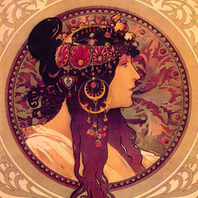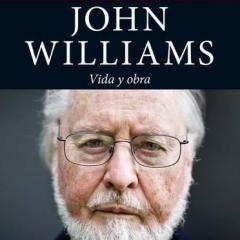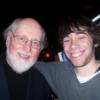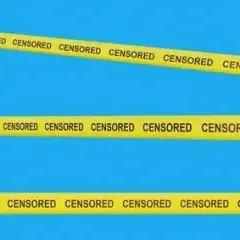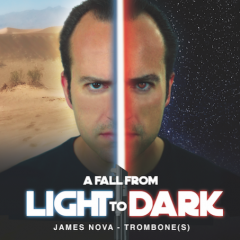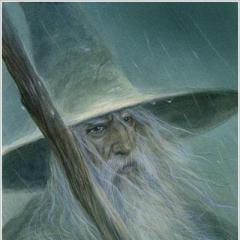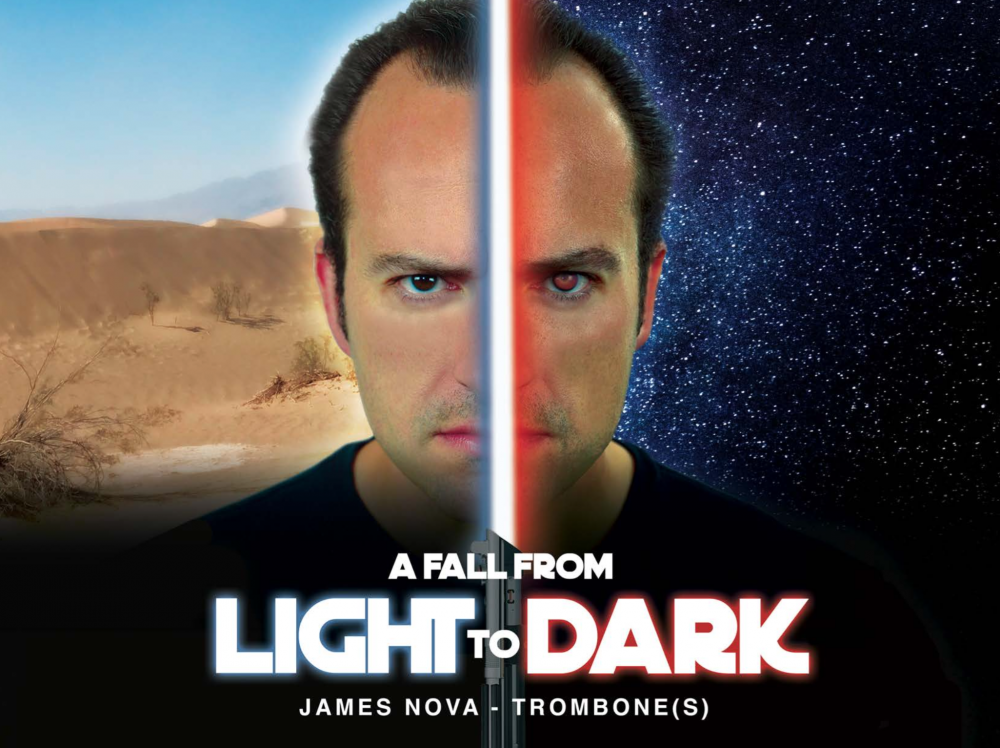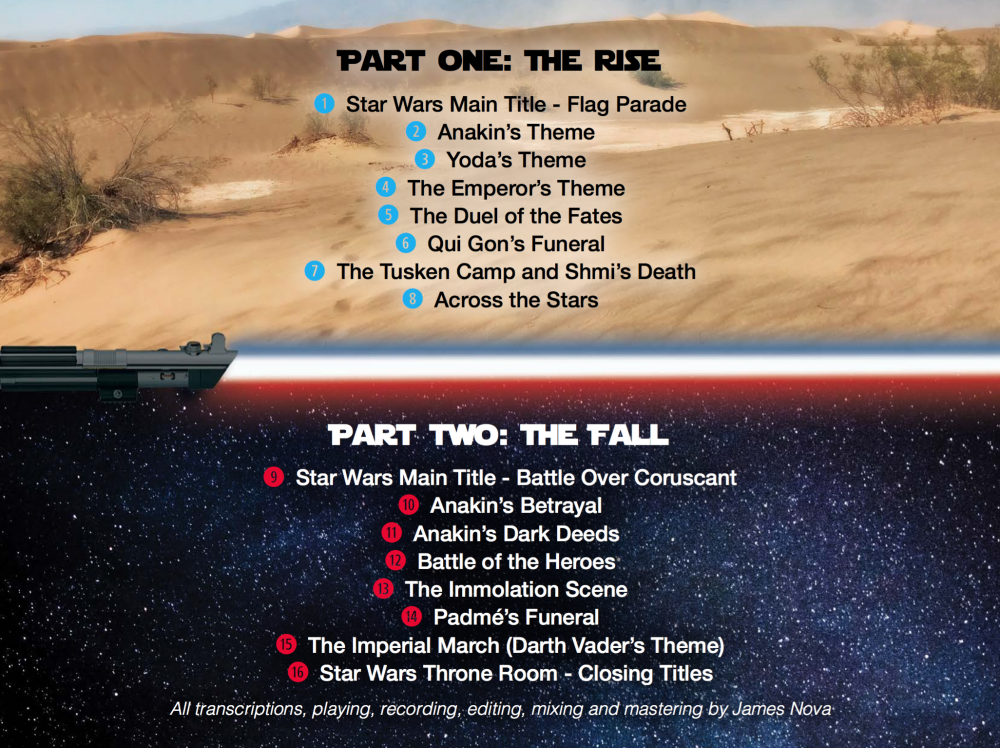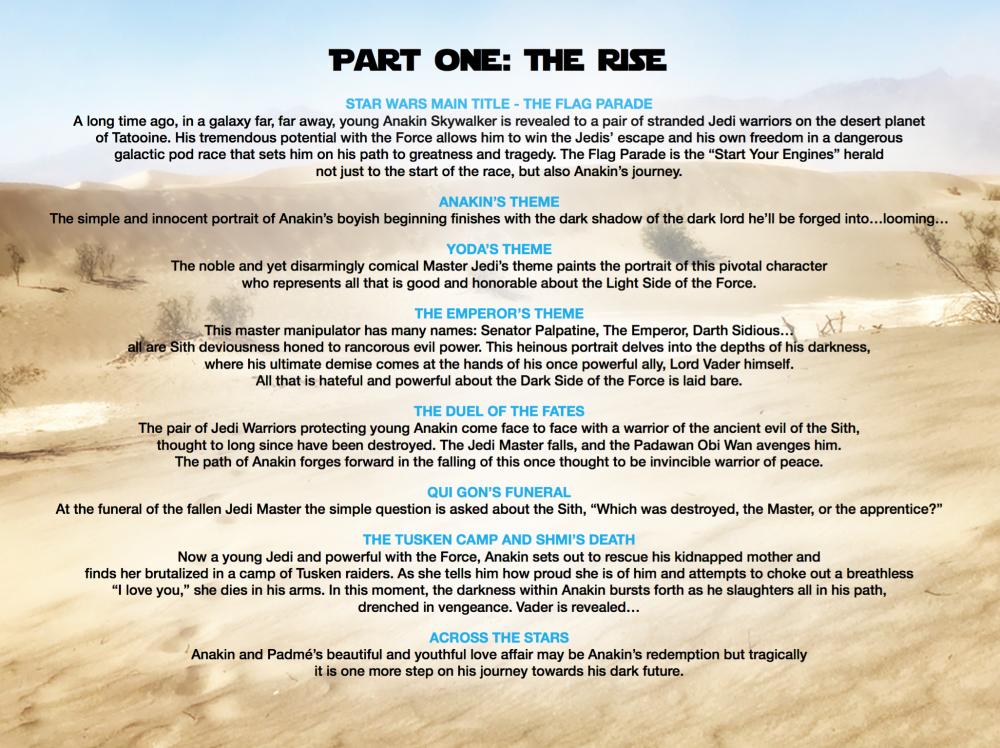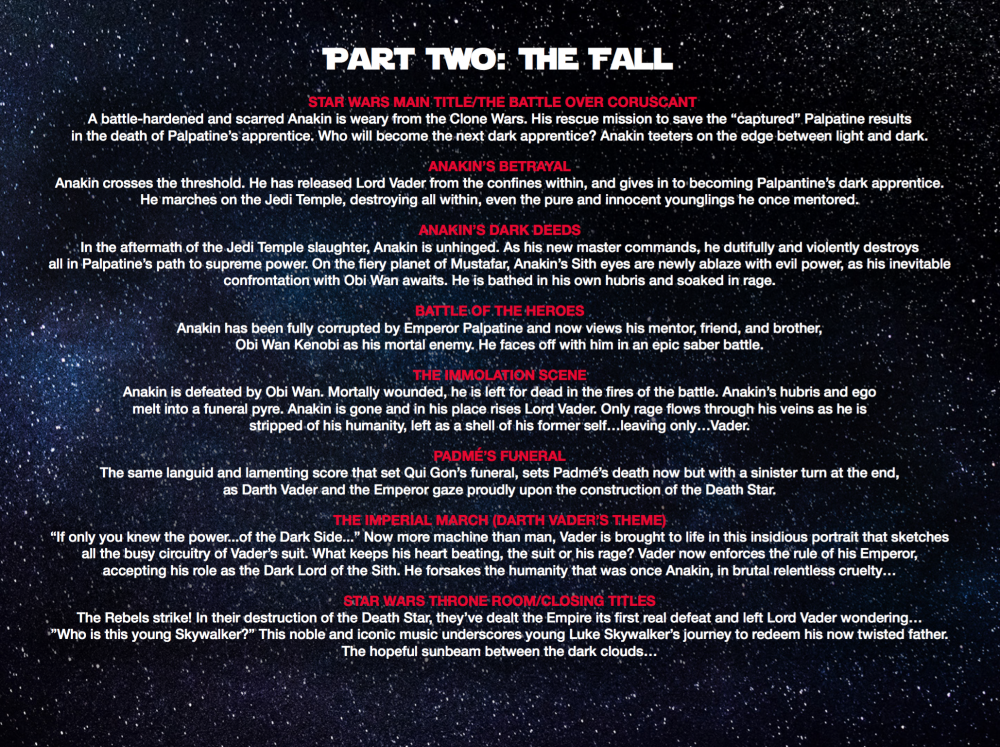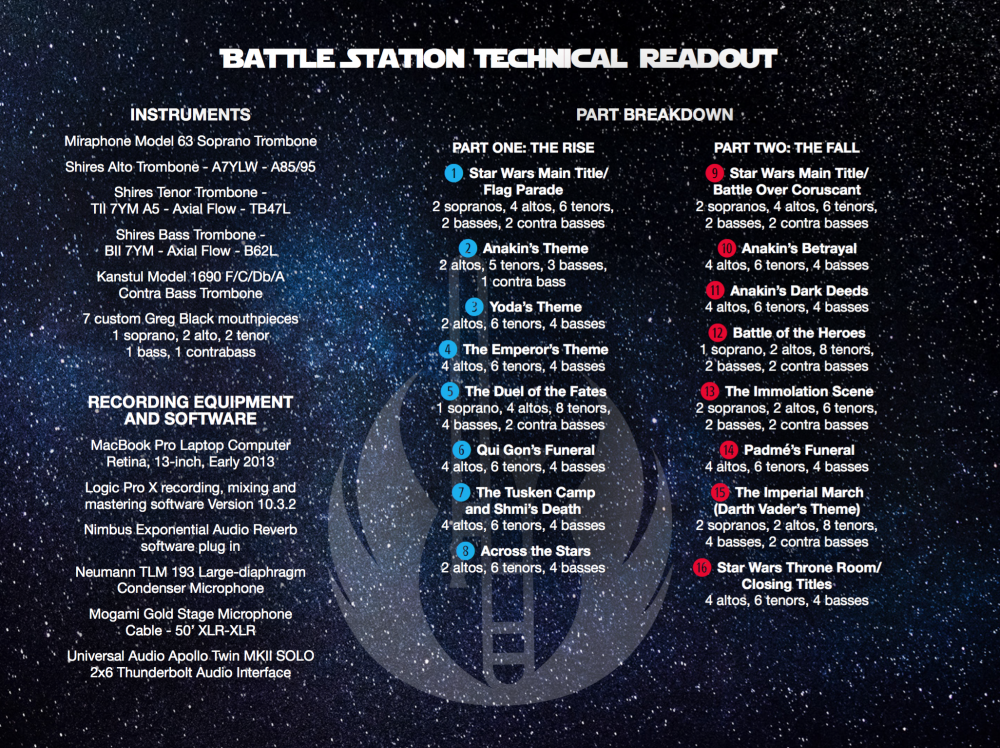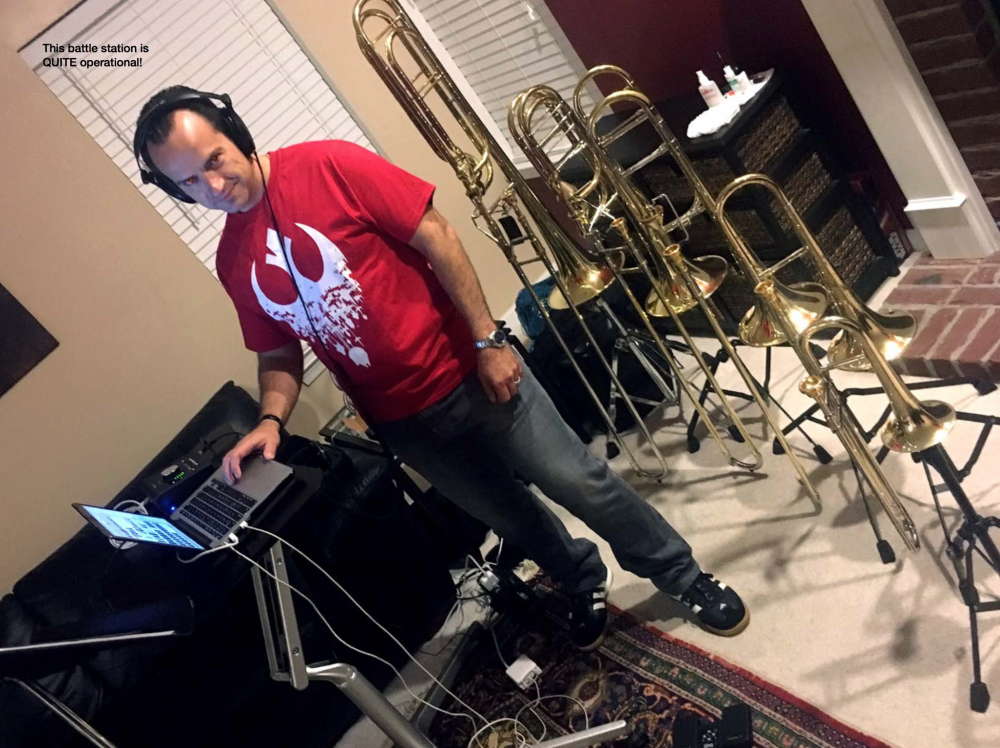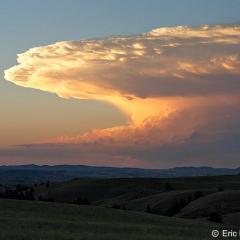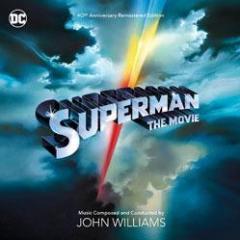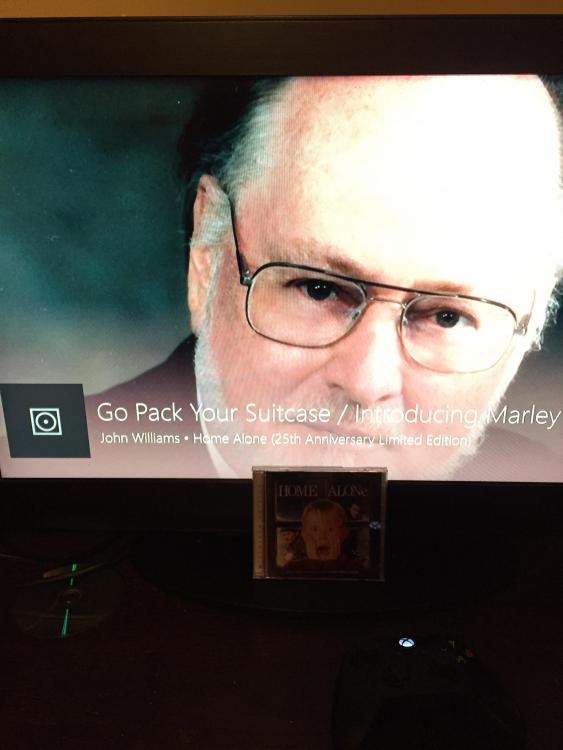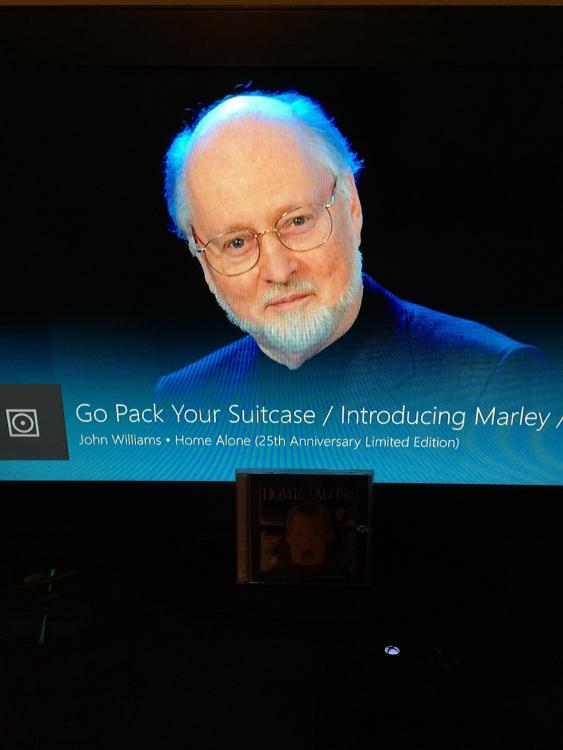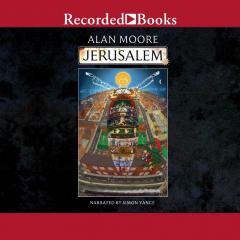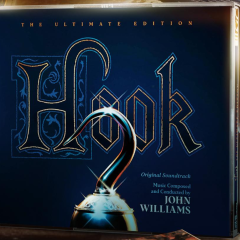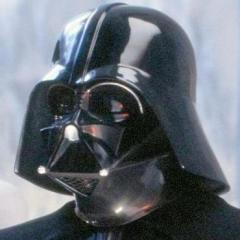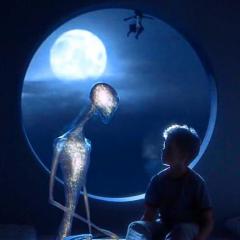Search the Community
Showing results for tags 'John Williams'.
-
Okay so a little time ago I created a thread of the CEOT3K Joke from Family Guy and thought it was kinda funny. Well tonight I was watching it again and noticed the newest episode of Family Guy had another one because of Christmas and figured let's make a thread of all the times Family Guy made a Williams joke. If you can think of one please tag it here. I think these should be listed here and well discussed about. Let me know what you think! Season 16 Episode 9: Don't be a Dickens at Christmas This joke features a recurring character named Opie playing santa for his children and afterwards he looks at the window and the theme from Home Alone starts as well as it recreates the scene in the real film where Kevin looks outside and sees the "scary" old man who wishes to see his grandchildren. Season 15 Episode 20: A House Full of Peters This jokes features Peter explaing to his wife why he has so many kids and only being a sperm donor once. He also is proven to that all the kids and they have things in common when when steps forwards and proceeds to fart the five note theme from CEOT3K. Peter then follows by communicating back the same notes but lower. This of course is a take on the ending of the film CEOT3K when the aliens and humans communicate at the end.
- 12 replies
-
- Seth MacFarlane
- Family Guy
-
(and 1 more)
Tagged with:
-
http://www.cleveland.com/musicdance/index.ssf/2017/05/cleveland_orchestra_announces_29.html#comments
- 35 replies
-
- Cleveland Orchestra
- John Williams
-
(and 1 more)
Tagged with:
-
Star Wars: The Last Jedi scoring Sessions 360 video
RICHARDSTRAUSS68 posted a topic in JOHN WILLIAMS
Thought you guys would like this:- 14 replies
-
- Star Wars
- John Williams
-
(and 1 more)
Tagged with:
-
- 1 reply
-
- John Williams
- Course
-
(and 3 more)
Tagged with:
-
The Last Jedi opened in the USA tonight, and in addition to the standard 7:00 pm showings, there was also a 6:00 pm showing that including free snacks, some swag, and exclusive visual content before the main film. Many thought the visual content would be a look at Solo: A Star Wars Story, so you can imagine my surprise when, after a spoken introduction recording by Rian Johnson, we were treated to a 5-or-so minute long tribute to Williams, and a look at his work on The Last Jedi. There weren’t any specific new things to me - it was mainly people praising Williams, and Williams talking about his process (still using paper and all). There was a shot of him and Daisy Ridley hugging, which was cute with Williams’ little crush in mind. There was also a beautiful statement of Leia’s Theme (EDIT: was Luke and Leia’s theme, got mixed up in the excitement of the moment haha!). Williams did touch on the topic of Episode IX right at the end. He said he hasn’t thought about it yet, but that he hopes his time with the Saga isn’t over. Hopefully this gets officially posted online, or is included in the Blu-Ray!
-
Hey everyone! Check out my new video, A Peek Behind the Curtain - The Making of Kylo Ren's Theme Overdub It shows how I make my recordings. Hope you enjoy it! Please check out my website and subscribe to my youtube channel!! https://www.youtube.com/watch?v=XtG6mBPNa2o James Nova Trombone - Pittsburgh Symphony Orchestra Brass Area Coordinator and Adjunct Trombone Faculty - Duquesne University Brass Coach - Three Rivers Young Peoples Orchestras jimnova.com
-
- john williams
- trombone
- (and 10 more)
-
I post this analysis, earlier featured in the JFK appreciation thread in General Discussion which I wrote ages ago but have recently dusted and polished to its current form. It is also a bit less ambitious and not to mention shorter than previous ones mostly because of the nature of the score. The Sounds of Intrigue and Innocence Lost – The Music of JFK - An Analysis of John Williams' score by Mikko Ojala Oliver Stone’s both controversial and acclaimed movie about the tragic events that took place on November 22nd 1963 in Dallas, Texas was a moderate box office success, blending both factual evidence and speculation into a potent mix to create a one of the most memorable and controversial movies of the 1990’s, dividing critics and movie buffs alike. The movie's script was penned by Stone himself with the help of Zachary Sklar and was based heavily on Jim Garrison's own autobiographical account of the JFK trial, in which he was the prosecuting counselor, called On the Trail of the Assassins. Sklar had been instrumental in releasing Garrison's work in 1988 and had worked as an editor on it and helped the author to shape and finish his manuscript, turning it from 3rd person scholarly work into obviously more marketable 1st person whodunit styled mystery. Another influential work was Jim Marrs' look at the alledged JFK conspiracy Crossfire: The Plot That Killed Kennedy and the author himself worked as a consultant on the movie project and the script. Stone's attempt with this film was not to try to solve the JFK murder or lay the issue at rest once and for all but to create a counter-myth to the Warren Commission Report, which he criticized as presenting a false and clouded picture of the events of the assassination. In the film as the plot to assassinate the president of the United States slowly unfolds with it’s myriad subplots and as the protagonist Jim Garrison starts to investigate it ever further the viewer is captivated and held in thrall for the whole three hours running time of the film. And even after that the film requires multiple viewings to be fully understood with all of its nuances and cross references. The fast and collage utilizing editing style of the film was to become Stone’s trade mark as he used flashbacks and forwards and fast glimpses of things happening elsewhere to create a feeling of unending intrigue and many layered meaning of the film’s events. To complement a very convoluted (some would say too convoluted) plot Stone hired a star studded cast with Kevin Costner as the sympathetic everyman prosecutor Jim Garrison, Sissy Spacek as his wife, Gary Oldman as Lee Harvey Oswald and Tommy Lee Jones as the main antagonist Clay Shaw, only to name a few of the prestigious group. Numerous smaller roles were filled with screen legends like Walter Mathau, Ed Asner and Jack Lemmon who lent the film credence, prestige and excellent performances. These fine actors bring enormous amount of talent but also believability and sympathy to these characters, helping the audience to relate to them in this plot heavy film. For this tragic piece of American history Oliver Stone chose perhaps the best possible composer, John Williams, whose music has in part come to stand for the American culture and national pride, capturing both Olympic Games and their spirit and historical jubilees of USA’s national celebrations and his scores have worked their way into the consciousness of the American public to an unprecedented extent. Stone had previously worked with the composer on Born of the Fourth of July in which Williams had used his lyrical and dramatic talent to portray the hardships and experiences of the Vietnam veteran Ron Kovic to beautiful and powerful results, capturing both the anguish and the idealism with his memorable themes and underscore for that film. After JFK the collaboration would continue with another political and historical drama, Nixon, in 1995 and add another impressive score in the composer's discography. But this assignment was quite different compared to the 1989 movie. Williams’ task was two fold. His music would have to convey all the mystery and intrigue of the assassination plot but also illustrate a more human side of the tragedy and capture the spirit of the Kennedy era of 1960’s along with its feelings of hope and promising future. His music would also have to create a bond between the family of Garrison and the audience, making the main protagonist relatable and human, an everyman caught in the midst of a whirwind of facts and falsehoods. The major challenge was also the fact that he had to write the music even before he had seen a frame of the film. According to both Richard Dyer’s 1992 Boston Globe interview with Williams and Oliver’s Stone’s DVD commentary, Williams visited the site of Dealey Plaza and the sets and the New Orleans shoot and discussed the subject thoroughly with Stone to get the feeling of the movie and then began his compositional challenge. The end result was 6 musical sequences reflecting different aspects of the film and were to be used in the movies in various ways. In the Boston Globe interview from 1992 Dyer mentions that these 6 pieces pre-recorded for the film were "Kennedy Theme" (aka Prologue), "The Motorcade", "The Conspirators", "Garrison's Obsession", "Garrison Family Theme", and "Arlington". Additional musical material followed during the filming and post production and some of it found its way on the soundtrack album as well. The effect and the fit of the music in the final film is amazing when we regard how early it was written and how effortlessly it permeates the film and the viewing experience. Though the music was in quite large part written in advance, it seems likely that many scenes were still spotted by Williams and Stone since it is hard to believe the match of the image and music in the film is just sheer good luck and editing. Williams himself says this in a 2000 interview with reporter Ray Bennett: And so much of that score, I’d say a third of it, was written and recorded before he [Oliver Stone] photographed the film. I loved working that way and I think Oliver did also. Alas, we do it all too infrequently. It can be very rich in terms of the closeness of the wedding of the music and the editorial life of the film. There’s an incestuous bond that happens that way that’s tighter than even the most expert fitter of post-synch music can get. The fact that the music was composed so early poses a problem when you begin to analyse the music from structural or architectural point of view. The use of themes and their approximate function or leitmotific meaning can be accertained only from the interviews and DVD commentary or the track titles of the soundtrack album and you can never be entirely sure if the reoccurring phrases are not just there because they fit the scene or as actual thematic links, but I have tried to separate reoccurring musical signatures from repeated underscore. Oliver Stone’s style of editing in this film requires quick changes in the music as well, but there are luckily many sequences where the score gets to shine, providing defining mood, rhythm and subtext to the scenes. But in many instances only small snippets of Williams’ musical suites were used and there is even additional music credited to a Canadian duo of composers called Tomandandy (information from film's credits and IMBD) and even Williams’ older music from Born on the Fourth of July ended up being used in the film. This renders the track-by-track analysis of the score in the movie difficult if not almost entirely unfruitful since the musical architecture is that of a music editor and not the composer himself. I try to discern here the main thematic material used in the score from Williams’ soundtrack album and based on how these themes correlate with the use of the music in the film itself. Themes of JFK: The Prologue Theme (Theme from JFK): John Williams had strong notions about John F. Kennedy and the era of his administration and he apparently poured it all into the main theme, which stands as the focal point of the score stylistically and emotionally. The theme contains a long singing melodic line, which is optimistically noble and bright, signifying the mindset and hopeful era of Kennedy’s and 1960’s. This is the main reoccurring idea throughout the movie and is varied from full orchestra of the Prologue to a soft piano renditions for Garrison family, the melody of the theme lending itself to countless variations. JFK Snare Drum Motif: Actually a part of the JFK main theme this brisk tattoo-like motif on the snare drums often appears to symbolize the military aspect of the whole affair as well as the Kennedy family. It is used many times instead of the main theme to signify the Kennedys but also the underlying threat from the often unseen cabinet and members of the military, who do not approve of the president or his policies. Interestingly enough this musical idea also returns in the next Oliver Stone/Williams collaboration, when Williams uses this same motif in Nixon when we see Kennedy landing in the Love Field airport in Dallas on the 22 of November. It gives a hint of things to come and is a clever reminder of the earlier film creating continuity beyond the limits of one movie. The Conspirators Theme: Rhythmic piece with staccato percussion, synthesizer and piano that relentlessly repeats the same rhythmic patterns in the background as the strings and brass create a brilliantly simple but undeniably one of the most memorable intrigue and suspense themes of the 90’s, heavily influential to both Williams’ later similar material in scores like Jurassic Park and Nixon but also popping up in the works of other film composers ever since. Steady rhythm and the ticking metronome percussion create a feeling of continual scheming and intrigue. This theme is used in many scenes but most of all the ones involving Clay Shaw, David Ferrie, the Cubans and Lee Harvey Oswald speaking about or planning the assassination. The rhythm draws also a connection to the often breathlessly nervous character of David Ferrie as well, who also has a small percussive idea of his own in the film. The Garrison Family Theme: A warm but ultimately sad and yearning melody for the family life disrupted when Garrison starts to immerse obsessively to the murder investigation, but also conveys the love and warmth Jim feels for his family. It starts with solo played by cor anglais that has become along with oboe Williams’ chosen instrument to portray family and the nostalgia and safety of home in his scores. Interestingly this musical idea is heard most often in the scenes where the rift in the family is emphasized, the music depicting more the fragility of Garrison’s family than the familial support or homeliness, almost an elegy for a family lost, caught helplessly up in a web of much larger intrigues raging around them. The concert version on the soundtrack album ends to an abrupt dissonant chords as if to show the danger that the investigation poses to the whole family as it in fact did. The Assassination Motif: A short repeating, in Williams’ own words almost minimalistic, threatening 11-note motif for the assassination. It consists of two repeated 4-note phrases and a 3-note ending. The small idea is highly cyclical but Williams cuts it by one note in the last phrase, thus creating a suitable halt to its motoric progression. Used many times through the movie in the scenes involving the approaching and imminent assassination or conspirators talking about it. A full presentation of this idea can be heard on the soundtrack album on the track called The Motorcade, which is Williams’ reflection of the moment of assassination itself and used to a great effect in the film during several sequences depicting the events of the Dealey Plaza. David Ferrie Motif: It is a bit unclear if this really is a motif or composed by Williams but Ferrie receives his own short percussive musical idea that is featured in a couple of scenes. It is basically a slowly quickening rhythm on percussion and sounds very Latin American, again drawing further subtextual connections to the Cubans. This motif is used to a great effect in the captivating scene where Garrison interviews Ferrie in a room in the Fountainbleu hotel as he gets more and more agitated as he rants about the assassination and the US intelligence community and his involvement in the plots, the pace of the music quickening with his breathless tirade. Arlington: The name of the piece refers to the military graveyard in Washington, where John F. Kennedy is buried. In this piece Williams has created a self contained string elegy in the memory of the dead president and also to mourn the disaster of the assassination of JFK and the many victims of the following events, the piece having a tragic feel of lost innocence. The theme starts with a elegiac French horn solo that suddenly takes a dark turn from which the whole string section flows into a mournful and solemn meditation on a new melody. This piece is used in the film as Garrison finds out the full implications of the assassination and all the events that afterwards are linked to it (indirectly the Vietnam War, Lee Harvey Oswald’s fate and the cover-up of evidence and facts by the intelligence community) and also as part of the pre-trial montage. It is a presentation of sorrow and lament for the whole tragedy, an elegy for the nation. This is also the piece that is featured in its entirety in the end credits, a somber musical message for the departing viewers. Track-by-track analysis of the score on the Original Motion Picture Soundtrack: Most of the cues found on the album are concert versions of the main musical ideas, thematic suites Williams composed for the film for Oliver Stone to use editorially as he saw fit and thus they reflect the themes in their original form so I won’t describe them in detail a second time. In the analysis I will focus on the score tracks only and do not concern myself with the source music featured heavily in the film and also on the OST album. The track numbers correspond to the soundtrack album sans the source music. 1. Prologue: The movie opens with a montage of Eisenhower’s farewell adress to the nation and Martin Sheen narrating the events of the Kennedy era and so Williams has a chance to start off with a formal and heraldic musical introduction. The piece begins with a short, precise and repeated snare drum line, a motif for the Kennedys, and then the main theme emerges on a solo trumpet, played here with grace and lyricism by Tim Morrison, a member of the Boston Symphony orchesta and the principal trumpetist of Boston Pops, who already lent his talent to the first Williams/Stone collaboration Born on the Fourth of July. The theme sings of a better future full of nobility, pride and glory, the tone of the lead instrument bright and warm. The lone trumpet is joined gradually by whole orchestra, brass playing heraldic and glowing under the soaring strings. At 2:03 a new thematic element is introduced, a light, lilting, innocent motif on the flutes backed by other woodwinds which again melts into the main theme around 2:32 as it finally comes to a serene close with solo trumpet, harp, assorted chimes and flutes. In the movie version of this cue the Conspirators Theme edited into it as the prologue montage refers to Castro and Cuban situation of the 1960’s. 2. The Motorcade: A musical counterpart for the assassination scene, this cue is tense, menacing and not to mention a brilliant piece of orchestral writing. Here Williams uses the 11-note assassination motif as the building block for the whole orchestral tour-de-force, kinetic and ominous. It begins with clarinets playing the assassination motif which is carried shortly to the rest of the woodwinds over tense strings and rumbling grand piano until suddenly the brass make a statement of the motif, the music growing ever stronger as it progresses around the orchestra as the president’s motorcade closes on the Dealey Plaza. Fast paced piano solo punctuates the brief respite from the growing orchestral forces but again restating the assassination motif in fragments just before the cue builds into a furious, almost cacophonous climax with snare playing the JFK motif, brass playing the main theme, strings sawing away dissonant chords, woodwinds again taking up the assassination motif and Williams even adding a bagpipe into the musical confusion, perhaps as a subtle homage to JFK’s Irish heritage. As the car brakes the assassination motif swirls maniacally out of control and suddenly the killing shots ring out punctuated by brass and percussive orchestral hits as Garrison shows the last shot on the Zapruder film, Kennedy getting shot in the head, over and over again: Back and to the left, back and to the left. From here on the music rumbles and churns on menacingly before fading into uncomfortable silence on the last notes of the still repeated assassination motif. 3.The Drummer’s Salute: A traditional military snare drum tattoo performed by the Royal Scots Dragoon Guard but Williams cleverly introduces the Main theme on deep brass underneath percussion’s rapt stance. This piece is used as part of the opening montage showing the streets of Dallas just before the assassination, a subtle yet somehow unsettling harbinger of things to come, the tone and mood of the main theme subdued and gloomy. 4.Theme from JFK: A piano arrangement of the piece shows also the more delicate side of the theme compared to the idealistically orchestral, stately and brassy Americana of the Prologue. In the film this version represents most often the love of Garrison towards his family and the more personal sadness over Kennedy's fate. The concert version ends with mounting crashing dissonance as if to imply the horrific end of JFK. 6. Garrison’s Obsession: driving, fast and cyclical 10- note piano figure imparts a powerful sense of pursuit, danger and confusion. Brass section and strings join the fray and the piece grows progressive louder and full of sense of mounting menace, augmented by tubular bells and exclamatory brass. This piece is used many times in the movie though the most memorable occasions are when Oswald is arrested in the movie theatre and when Garrison is attacked at the airport (new scene on the Director’s Cut DVD). 8. The Conspirators: The original and unedited version of the Conspirators Theme. The theme is most often featured in the scenes featuring Ferrie, Oswald, Shaw and the Cubans planning the assassination but also during scenes involving these plans in some way indirectly, the piece ticking away oppressively and obsessively underneath the dialogue. 9. The Death of David Ferrie: Used in the scene involving Ferrie’s death but also elsewhere to imply sinister forces and unexplained happenings in the movie. Again this cue is edited into many other scenes. It creates an eerie, foreboding feel through the use of ghostly synthesized choir, low brass and strings along with different synthesized effects in the background. Atmospheric and ethereal it creates just the right unsettling mood for the scenes it underscores throughout the film from Garrison's investigations to Oswald's past to the ominous meaning of the death of David Ferrie. 11. Garrison Family Theme: A concert arrangement of the Family Theme featuring cor anglais as a solo instrument. In the movie there appears another version of this theme on solo piano as well. It is the least used of the themes perhaps not to over sentimentalize the mood of the film but where it is used the warmth of the melody is always counterbalanced by a certain melancholy, a comment on the strained familial relationship of the Garrisons. 14. The Witnesses : Another moody and tense underscore cue that is full of dark orchestral rumbles and threatening synthesizer effects that ebb and flow without discernible themes to augment the somber and dark feel of many scenes. Here Williams comes closest to sound design in his writing, the musical landscape created largely to unsettle and disturb, a perfect subtle unnerving accompaniment to Stone's images. 16. Arlington: This concert arrangement features a noble and wonderfully serene French horn solo and the string elegy which is one of the most beatiful and at the same time heart wrenching pieces Williams has ever created. Full of sorrow and dignity but also pathos and anguish it is the highlight of the album. The music begins with a mournful rendition of the Main Theme on solo horn, played by the ever brilliant James Thatcher, the most frequent horn soloist on Williams’ soundtracks, the ruminating and serene nobility of the musical idea suddenly taking a turn into foreboding and darkness and the string section begins a new tragic and elegiac theme, a lament for the slain president. This new elegy soon gains darker undercurrents as low register string figures encounter the high strings, that in the end reach a chilling almost violently slashing climax. The primary string theme then returns calmer and sorrowful again as if the just heard expression of musical rage had taken its toll and as if the struggle against the injustice of the assassination and events surrounding it had drained the orchestra and with its last resigned notes the piece slowly slides, note by note, into a calm silence. 17.Finale: The track starts with a darker reading of the JFK theme on trumpet, similar to the horn rendition of heard in Arlington, but leaps from there to a radiant performance of the main theme with more powerful orchestration than before as if to say in its triumphant tones that even though the case against Shaw was lost Garrison had done something historic and honorable in his attempt to solve the assassination plot of JFK against all the forces lined against him. Williams’ does create a strong sense of accomplishment and finality, some would say that he does it here falsely since the film ends in a defeat, but the composer is emphasizing the ideals and principles, not Garrison or his case specifically, but the effort to uncover truth, in itself a noble endeavour. The rather more sombre answer to the whole JFK story comes in the end credits where the above mentioned Arlington offers a more ruminating and reflective but ultimately mourful take on the whole affair. 18. Theme from JFK (Reprise): In typical Williams fashion, the composer reprises the piano rendition of the main theme to close the album with a sense of things coming a full circle but in doing so also ends the entire experience in the sudden disturbing rising and resonating thunderous rumble from the orchestra, almost like a grim question mark. This could be seen as highly fitting as the whole JFK assassination was left unsolved as well, the music reminding us much as Stone's film to study the past. © Mikko Ojala
- 28 replies
-
- JFK
- John Williams
-
(and 2 more)
Tagged with:
-
I just noticed that my hometown symphony orchestra Oulu Sinfonia here in Finland will be performing Williams' Oboe Concerto on the 15th of February 2018. There are a few Finnish John Williams fans here on the messageboard so thought to post this news in its own thread. You can find more info HERE. Below is the programme of the concert:
- 9 replies
-
- Oboe
- John Williams
-
(and 3 more)
Tagged with:
-
Amazon.de is currently selling the 2 CD Intrada release of Jaws 2 for 5.25 Euros: https://www.amazon.de/Jaws-2-Soundtrack-John-Williams/dp/B017I09FQ4/ref=zg_bs_5695936031_94?_encoding=UTF8&psc=1&refRID=MFADHMB27GEYQA7PJ8RD
- 70 replies
-
- John Williams
- Jaws 2
-
(and 1 more)
Tagged with:
-
As a comment to the below Youtube video, a user wrote: I was so confused about John Williams' overly accomplished life until I realized that film composer John Williams and classical guitarist John Williams are in fact two different people. The trouble that understanding could have saved me in my undergrad...
-
I think he should run for president. In Norway.
-
Pittsburgh Symphony Trombonist Releases Star Wars Album James Nova, trombonist in the Pittsburgh Symphony orchestra, has released a new album for trombone choir, A Fall from Light to Dark. Through the chosen moments of John Williams’ masterful scores, this album musically chronicles the rise and descent of Anakin Skywalker as he transforms into Darth Vader. Jim has had a lifelong love of John Williams’ film scores since his Dad took him and his brother to see The Empire Strikes Back in the theater. Throughout his career he has performed and recorded with John Williams on several occasions, with the Pittsburgh Symphony Orchestra, the Boston Symphony, the Boston Pops as well as the Utah Symphony. In 2012, Jim was preparing for another season with the Pittsburgh Symphony and thought a fun way to get into shape would be to overdub (or “Novadub”) one of his John Williams trombone choir transcriptions. He chose his transcription of the Superman March as his first effort. He posted it on SoundCloud. Fast forward to now and his SoundCloud page has passed 600,000 listens! He decided it was time to make an actual commercial album and set out learning the art of mixing and mastering, which brings him to this project: A Fall from Light to Dark. Some of you may think, “trombone choir?” Trombone choir is a rich and varied color ensemble capable of powerful, crushing, devastating and also tender, introspective, delicate moments. This album demonstrates the power of John Williams’ scores and how they translate so well to this medium. All transcriptions, playing, recording, editing, mixing and mastering by James Nova. To hear some clips and learn more about Jim, visit jimnova.com
- 13 replies
-
- anakin skywalker
- star wars
- (and 5 more)
-
We all know John Williams is one of (if not the) best film-score composer of all time. We also know that because of this, we cannot really compare him with classical composers; film composing is just something different. However because he does write for a symphony orchestra, we can compare composing techniques and styles. My question then becomes: where would you rank him among the well known classical composers? For example, in my opinion, both in creating melodies as well as in colourful orchestration, he really is (almost?) on par with the great Russian composer Tchaikovsky. Let me give an example. If you compare Luke and Leia (from ROTJ) with In a Pine Forest (from the Nutcracker ballet, composed by Tchaikovsky), I think one cannot immediately say one of the pieces is better than the other as a composition, even without the film/ballet. What are your opinions? Curious to find out!
- 50 replies
-
- John williams
- Classical
-
(and 1 more)
Tagged with:
-
http://variety.com/2018/film/news/mark-hamill-on-star-wars-music-composer-john-williams-1202659494/ John Burlingame did another write up on John Williams and this time talked to STAR WARS actor Mark Hamill. What was supposed to be a five minute chat ended up in much longer interview that it warranted a new spin off article to what Jon did yesterday. After reading this I sent this message to Jon Burlingame: 'He is the entire cast ' What a great and humble way of (showing) respect to our Maestro: Williams. I'm so moved. And it appears that the same quote left Jon Burlingame in quite an awe. He responded back to me: "I was so taken with these thoughts that I felt I simply had to write a separate story. The plan had only been to get him on the phone for five minutes to confirm what I had heard about his admiration for the Maestro. But boy, that last quote sealed it for me"
- 15 replies
-
- THE LAST JEDI
- STAR WARS
-
(and 1 more)
Tagged with:
-
None But the Brave Music Composed by John Williams A Review of the Soundtrack Album by Mikko Ojala None But the Brave is a 1965 film and one of Williams' first real dramas and a war story no less, directed by Frank Sinatra, who himself played a supporting role in the picture. It tells the story of American and Japanese soldiers, stranded on a tiny Pacific island during World War II, who have to form a temporary truce and cooperate to survive various tribulations and is told through the eyes of the American and Japanese unit commanders, who must deal with an atmosphere of growing distrust and tension between their men. Film Score Monthly released the score in 2009 for the first time, the album featuring the complete score and even some bonus material and once again credit has to be given to the FSM for their continued interest in releasing and preserving the music from earliest eras of John Williams career. It is fascinating to chart the evolution of Williams' sound and style through his early scores as what you hear is a lot of talent ready to burst into full bloom as it later does but also a sort of learning curve of a composer slowly picking up certain skills of the craft and fine tuning them. However in the case on None But the Brave there is also a good dose of maturity found here. This score exhibits many of Williams' clear stylistic tendencies and gift for melody but perhaps in a slightly reduced or muted format than in many of his later scores. On album the score forms quite a strong listening experience though perhaps requires a bit more patience than your average JW soundtrack. John Williams has always been a writer of memorable melodies and his main theme for the score certainly is a good example of this, a heroic, resolute but pensive melody often heard on solo brass but he weaves it through many orchestrational variations and uses fragments here and there to tie the score together. The film is not out to glorify war and Williams' somber theme and its rather sparse usage reflect that in an admirable way, the theme being a form of musical solace between the tragic and suspenceful elements in the music. Main Title and Kuroki's Introduction presents the main idea in an almost formal heraldic fashion, but we hear also another important idea in passing here, namely Kuroki's Japanese styled motif, very faux oriental progression on flute almost archetypical you could say, which is later explored in a more thorough fashion, the idea revealing more emotional depth later on in cues like Kuroki's Reflection and The Dream of Hope Is Ashes / Hirano's Problem. These two form the opposing musical sides of the story but in the end the composer uses the main theme for both the Americans and the Japanese, their tragedy of war itself becoming one and the same. That said the score might not feel straightforwardly and winningly melodic at first as much of the opening half of the album is focused on suspence and action writing, both reminding of the concurrently written music for Lost In Space in their certain sparseness and terseness, even though small motific ideas spin throughout to tie the pieces together. Especially the wandering fluttering woodwind motifs remind me of the aforementioned TV-series as does some more suspenceful writing for forcefully rhythmic brass and lower strings. E.g. Busy Hands / Kuroki Prepares for War / Fishing Spear, Night Adventure, Brothers in Command / The Water Hole and Waiting for Battle all feature this tense militaristic suspence and action, snare drums and muted snarling brass and rumbling woodwinds. It is interesting to note how many of these techniques, e.g. furious kinetic string and woodwind runs and tense muted brass are carried to Williams' classic scores and appear still 20 or 30 years hence. The composer also has a few chances for light comedic scoring in places and he incorporates a few traditional Japanese tunes into the underscore, often to provide lightness and humor but this also brings some variety and colour to the tone of what is otherwise mostly suspenceful and tense music. But the composer's definite dramatic sense is strong here, the emotional writing for some dire situations in the film gradually rising to truly satisfying heights but only in the latter half of the score (from Uneasy Peace / Okuda and Craddock onward) the music warms up and we hear the themes more often and in a more emotionally resonant guise culminating in the powerful and tragic The Final Fight / The Spirit Lives / End Cast, which rounds up the score on a resounding if somewhat sombre note. This progression and build-up through the album is very effective and reflects the narrative of initial hostilities turning to friendship and back to war again and slowly but surely the music reaches this final confrontation and dramatic peak and the composer makes it seem very natural from musical story telling perspective, a show of his dramatic instincts and skill in crafting a strong architecture through the score. In this score you can hear that Williams is undeniably already developing his own vocabulary and musical voice and showing great promise and he also has here a rare chance to show his dramatic talent amidst all the comedies he ended up scoring in 1960's. I would say this is a surprisingly mature and well conceived score although it might lack the immediate appeal of the Maestro's classic accessibly melodic scores with catchy main themes. But after a few listens you start to hear the intricacy of Williams' music and the more subtle thematic progression he is building. In addition to the complete score the FSM album also contains extensive and highly informative liner notes and track-by-track analysis by Jeff Eldridge and a few bonus tracks, a terrific piano rendition of the main theme by the Maestro himself, which is a worthy addition and was planned to be released as a single but got cancelled, a luau styled Hawajian radio source cue and a couple of alternate orchestrations of Kuroki's Introduction and a robust trailer version of the main theme. At the end of the album to round out the listening experience FSM included as a curiosity the only music previously released from the film, an LP single titled None But the Brave sung by Jack Halloran Singers, a rather schmaltzy affair with an equally saccharine version of Sylvia, the B-side of the single, a song version of David Raksin's theme for a movie of the same name both from 1965. A solid early dramatic score from John Williams, certainly worth the spin to his devoted fans but casual listeners might not be entirely won over by it. 3½-4 stars.
- 6 replies
-
- Soundtrack
- FSM
-
(and 5 more)
Tagged with:
-
No reactions on Twitter about the score yet. Don't really want to read too many reactions lest someone reveals some huge spoiler. Also, is it weird we've heard next to nothing from JW about the score? TFA had, what, two separate featurettes with JW, two 60 Minutes features, a 30 minute Tavis Smiley interview, countless newspaper articles. I think the only time JW's even mentioned TLJ was that radio interview for the Spielberg/Williams collaboration, plus the infamous "I don't want anyone else scoring for Daisy!" anecdotes at his concerts.
-
You can discuss the trailer itself in the thread for the film, please limit discussion in this thread just to the music. Thanks!
-
http://buysoundtrax.stores.yahoo.net/hyorsobydond.html SRP: $17.95 HYPERSPACE is a limited edition release of 1000 units. FIRST 50 Copies will be autographed by composer Don Davis LISTEN TO A SOUND CLIP FROM the score for HYPERSPACE https://tinyurl.com/ybzl7437 Dragon’s Domain Records, distributed through buysoundtrax.com, presents the long out-of-print orchestral score to HYPERSPACE, composed by Don Davis. One of the first feature length STAR WARS parodies, HYPERSPACE came out in 1984. Known in England as GREMLOIDS and as GREMLORDS in France and Germany, HYPERSPACE was writer/director Todd Durham’s second and last film as director, working with ambitiously cost-conscious low-budget producer Earl Owensby. The movie was released in September 1984, but it wasn’t until 1988 that the film received a wider release on home video. Starring comedians Chris Elliott and Paula Poundstone and filmed in North Carolina, HYPERSPACE imitates STAR WARS in context and execution from its opening text crawl into infinity to its inscrutable helmeted monarch of menace, Lord Buckethead (played by Robert Bloodworth, but voiced by Barry Cooper). Lord Buckethead is hot on the trail of vital radio transmissions stolen from the corrupt Galactic Alliance by members of an allied resistance force. Buckethead intends to get them back, aided by diminutive, Jawa-robed minions known as gremloids. However, unbeknownst to him, he has made a serious navigational error, and rather than reaching his intended destination he lands instead upon the Earth, where he and his gremloid faction march into the closest small town and proceed with their mission. A purposefully STAR WARS-esque orchestral score was provided by newly-minted composer Don Davis, in his first feature film score. Performed by a live, 56-piece orchestra, Davis’s music provided the film with its missing gravitas; and it made enough of an impression among Hollywood film music folk that it led to a lasting and respectful career scoring films and television, including TV’s BEAUTY AND THE BEAST and SEAQUEST DSV and blockbuster films like THE MATRIX series and JURASSIC PARK III. “Obviously the movie was a parody of STAR WARS, so the only approach to music I could logically take was similarly a parody of John Williams’s work,” said Davis in an exclusive new interview for the album notes. “I got as close to STAR WARS as I could get without it being STAR WARS.” Davis provided the right kind of feeling to the music which gave the score a suitably grandiose dynamic and aided in the film’s parodist nature. The composer’s approach to supporting the film’s inherent humor was based on “not writing funny music,” but scoring the movie with absolute seriousness, thereby allowing the parody to exist within the film and among its characters in a world where even the most farcical of circumstances are treated with genuine integrity. “The concept of playing it straight, as if the show were not a comedy, was what we wanted to do with our movie,” said Davis. “We treated it as if it really was STAR WARS and everything was completely serious.” The film came and went without much ado or remembrance, but the music was noticed and that gave Davis an auspicious debut in this, his first opportunity to make the jump into… HYPERSPACE. The score was first released on an 11-track CD in 1993, paired with another Davis score. This expanded reissue from Dragon’s Domain Records includes eight previously-unreleased tracks. HYPERSPACE is a limited edition release of 1000 units and can be ordered at www.buysoundtrax.com. The first 50 units sold through the Buy Soundtrax website will include a booklet autographed by the composer. Ships the week of January 3rd. 01 HYPERSPACE Main Title/Pin Head 2:22 02 Meet The Mutants/Real Live Munchkins/ Dad’s Gland/ Basement Snoids 4:23 03 Alien Enzyme 2:00 04 Buckethead’s Promenade 2:01 05 Swamp Dog/Mister Ugly/ March of the Carrot People/Wild Bill Schwartz/Avoid the Droid/My Favorite Mutant 5:11 06 One Step Forward 0:56 07 Tree Trek 1:21 08 Old MacDonald Had a Farm Dirge 2:26 09 Neurotic Karen/Mutants in Bondage/Terminate The Princess/Zapping Aliens 2:01 10 Ship Witch/Life in Gland Land/Laser Trail 3:04 11 Just Browsing/After the Brain Drain 4:55 12 Max’s Coronary/Let’s Zap Ed/See You Laser 1:09 13 There She Is 0:45 14 Ding Dong Daddy 1:16 15 Max Incognito/Humanoids From Pacoima 4:27 16 Rugburn/Boiled Snoids 1:49 17 Imbeciles From Uranus 1:06 18 Droid McNoid/Buckethead’s Remorse 4:00 19 HYPERSPACE End Credits 3:24 Total Time: 48:31
- 4 replies
-
- James Horner
- Don Davis
-
(and 4 more)
Tagged with:
-
No extra music or anything, just "2 collectible cards" https://www.target.com/p/-/A-52936836 They have an entry for the normal edition too: https://www.target.com/p/-/A-52994365
-
what's this music https://www.ispot.tv/ad/w_lE/nissan-master-the-drive-sales-event-fulfill-your-destiny-altima
-
I was thinking about the famous "I'm flying" scene from Titanic and, in particular, the precise moment where the music reaches its emotional climax. On paper, you might expect the score to swell at the moment Jack and Rose kiss, but it actually reaches its emotional peak a few seconds later when Rose reaches up her hand to hold Jack's head closer. The moment becomes a lot more sensual and somehow more romantic as a result. I realise this is just intelligent, intuitive film scoring, but the timing of these things always fascinates me. (2:09) Another example off the top of my head is the final scene in Home Alone when Kevin and Old Man Marley share their moment through the window. One could score it so the music swells when Marley raises his hand in greeting, but Williams holds it for that little moment longer until Kevin returns the gesture, when both characters have completed their arcs with regards to each other. This video below actually has the alternate “O Holy Night” version of the cue too, and you can see the emotional journey is exactly the same in both pieces of music. (00:47) I’m curious to know if you can think of any other examples like this. Moments where the music could reach an emotional peak at one moment, but actually climaxes at another for a stronger emotional impact.
- 1 reply
-
- Score Talk
- John Williams
-
(and 3 more)
Tagged with:


